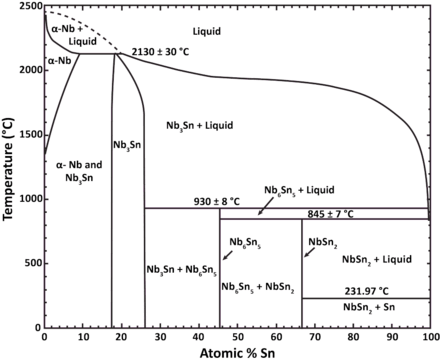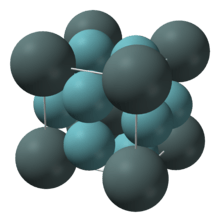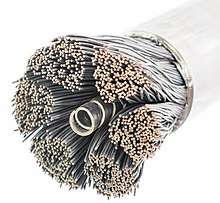Niobium–tin
Niobium–tin is an intermetallic compound of niobium (Nb) and tin (Sn), used industrially as a type II superconductor. This intermetallic compound has a simple structure: A3B. It is more expensive than niobium-titanium (NbTi), but remains superconducting up to a magnetic flux density of 30 teslas [T] (300,000 G),[1] compared to a limit of roughly 15 T for NbTi.

Nb3Sn was discovered to be a superconductor in 1954. The material's ability to support high currents and magnetic fields was discovered in 1961 and started the era of large-scale applications of superconductivity.
The critical temperature is 18.3 kelvins (−254.8 °C; −426.7 °F). Application temperatures are commonly around 4.2 K (−268.95 °C; −452.11 °F), the boiling point of liquid helium at atmospheric pressure.
In April 2008 a record non-copper current density was claimed of 2,643 A mm−2 at 12 T and 4.2 K.[2]
Niobium Tin Composite Wire

Mechanically, Nb3Sn is extremely brittle and thus cannot be easily drawn into a wire, which is necessary for winding superconducting magnets. To overcome this, wire manufacturers typically draw down composite wires containing ductile precursors. The "internal tin" process includes separate alloys of Nb, Cu and Sn. The "bronze" process contains Nb in a copper–tin bronze matrix. With both processes the strand is typically drawn to final size and coiled into a solenoid or cable before heat treatment. It is only during the heat treatment that the Sn reacts with the Nb to form the brittle, superconducting niobium–tin compound.[3] The powder-in-tube process is also used.[2][4]
The high field section of modern NMR magnets are composed of niobium–tin wire.
Strain effects
Inside a magnet the wires are subjected to high Lorentz forces as well as thermal stresses during cooling. Any strain in the niobium tin causes a decrease in the superconducting performance of the material, and can cause the brittle material to fracture. Because of this, the wires need to be as stiff as possible. The Young’s modulus of niobium tin is around 140 GPa at room temperature. However, the stiffness drops down to as low as 50 GPa when the material is cooled below 50 K (−223.2 °C; −369.7 °F).[5] Engineers must therefore find ways of improving the strength of the material. Strengthening fibers are often incorporated in the composite niobium tin wires to increase the their stiffness. Common strengthening materials include: Inconel, stainless steel, Molybdenum, and Tantalum because of their high stiffness at cryogenic temperatures.[6] Since the thermal expansion coefficients of the matrix, fiber, and niobium tin are all different, significant amounts of strain can be generated after the wire is annealed and cooled all the way down to operating temperatures. This strain is referred to as the pre-strain in the wire. Since any strain in the niobium tin generally decreases the superconducting performance of the material, a proper combination of materials must be used to minimize this value. The pre-strain in a composite wire can be calculated by the formula
where εm is the pre-strain, ΔL/Lc and ΔL/Lf are changes in length due to thermal expansion of the niobium tin conduit and strengthening fiber respectively; Vc, Vf, Vcu, and Vbz are the volume fractions of conduit, fiber, copper, and bronze; σcu,y, and σbz,y are the yield stresses of copper and bronze; and Ec, and Ef are the Young’s modulus of the conduit and the fiber.[7] Since the copper and bronze matrix deforms plastically during cooldown, they apply a constant stress equal to their yield stress. The conduit and fiber; however, deform elastically by design. Commercial superconductors manufactured by the bronze process generally have a pre-strain value around 0.2% to 0.4%. The so called strain effect causes a reduction in the superconducting properties of many materials including niobium tin. The critical strain, the maximum allowable strain over which superconductivity is lost, is given by the formula
where εc is the critical strain, εco is a material dependent parameter equal to 1.5% in tension (-1.8% in compression) for niobium tin, B is the applied magnetic field, and Bc2m is the maximum [Type-II superconductor|upper critical field] of the material.[8] Strain in the niobium tin causes tetragonal distortions in the crystal lattice, which changes the electron-phonon interaction spektrum. This is equivalent to an increase in disorder in the A15 crystal structure.[9] At high enough strain, around 1%, the niobium tin conduit will develop fractures and the current carrying capability of the wire will be irreversibly damaged. In most circumstances, except for high field conditions, the niobium tin conduit will fracture before the critical strain is reached.
History
Nb3Sn was discovered to be a superconductor in 1954, one year after the discovery of V3Si, the first example of an A3B superconductor.[10] In 1961 it was discovered that niobium–tin still exhibits superconductivity at large currents and strong magnetic fields, thus becoming the first known material to support the high currents and fields necessary for making useful high-power magnets and electric power machinery.[11][12]
Notable uses

The central solenoid and toroidal field superconducting magnets for the planned experimental ITER fusion reactor use niobium–tin as a superconductor.[13] The central solenoid coil will produce a field of 13.5 teslas (135,000 G). The toroidal field coils will operate at a maximum field of 11.8 T. Estimated use is 600 metric tons (590 long tons) of Nb3Sn strands and 250 metric tonnes of NbTi strands.[14][15]
At the Large Hadron Collider at CERN, extra-strong quadrupole magnets (for focussing beams) made with niobium–tin are being installed in key points of the accelerator between late 2018 and early 2020.[16] Niobium tin had been purposed since 1986 as an alternative to niobium-titanium, since they allowed coolants less complex than superfluid helium. This option was finally not pursued in order to avoid delays while competing with the then-planned US-led Superconducting Super Collider.
Developments and future uses
Hafnium or zirconium added to niobium-tin increases the maximum current density in a magnetic field. This may allow it to be used at 16 tesla for CERN’s planned Future Circular Collider[17].
See also
- Niobium-titanium, more ductile than Nb-Sn
References
- Godeke, A.; Cheng, D.; Dietderich, D. R.; Ferracin, P.; Prestemon, S. O.; Sa Bbi, G.; Scanlan, R. M. (September 1, 2006). "Limits of NbTi and Nb3Sn, and Development of W&R Bi–2212 High Field Accelerator Magnets". Office of Science, High Energy Physics, U.S. Department of Energy. Retrieved December 26, 2015. Cite journal requires
|journal=(help) - "Record current with powder-in-tube superconductor". laboratorytalk.com. Archived from the original on October 8, 2008. Retrieved September 6, 2008.
- Scanlan, R.; Greene, A. F.; Suenaga, M. (May 1986). Survey Of High Field Superconducting Material For Accelerator Magnets. 1986 ICFA Workshop on Superconducting Magnets and Cryogenics. Upton, NY. Report LBL-21549.
- Lindenhovius, J. L. H.; Hornsveld, E. M.; den Ouden, A.; Wessel, W. A. J.; ten Kate, H. H. J. (2000). "Powder-in-tube (PIT) Nb3Sn conductors for high-field magnets". IEEE Transactions on Applied Superconductivity. 10 (1): 975–978. Bibcode:2000ITAS...10..975L. doi:10.1109/77.828394.
- Bussiére, J. F.; LeHuy, H.; Faucher, B. (1984). "ELASTIC BEHAVIOR OF POLYCRYSTALLINE Nb3Sn, V3Ga AND Nb3Ge". Advances in Cryogenic Engineering Materials. Springer, Boston, MA. 30: 859–866. doi:10.1007/978-1-4613-9868-4. Retrieved May 20, 2020.
- Flükiger, R.; Drost, E.; Specking, W. (1984). "EFFECT OF INTERNAL REINFORCEMENT ON THE CRITICAL CURRENT DENSITY OF Nb 3 Sn WIRES". Advances in Cryogenic Engineering Materials. Springer, Boston, MA. 30: 875–882. doi:10.1007/978-1-4613-9868-4. Retrieved May 20, 2020.
- Steeves, M. M.; Hoenig, M. O.; Cyders, C.J. (1984). "EFFECTS OF INCOLOY 903 AND TANTALUM CONDUITS ON CRITICAL CURRENT IN Nb3Sn CABLE-IN-CONDUIT CONDUCTORS". Advances in Cryogenic Engineering Materials. Springer, Boston, MA. 30: 883–890. doi:10.1007/978-1-4613-9868-4. Retrieved May 20, 2020.
- Ekin, J. W. (1984). "STRAIN EFFECTS IN SUPERCONDUCTING COMPOUNDS". Advances in Cryogenic Engineering Materials. Springer, Boston, MA. 30: 823–836. doi:10.1007/978-1-4613-9868-4. Retrieved May 20, 2020.
- Godeke, A. (2008). "A Review of the Properties of Nb 3 Sn and Their Variation with A15 Composition, Morphology and Strain State". Superconductor Science and Technology. IOP Publishing Ltd. 19 (8): 68–80.
- Matthias, B. T.; Geballe, T. H.; Geller, S.; Corenzwit, E. (1954). "Superconductivity of Nb3Sn". Physical Review. 95 (6): 1435. Bibcode:1954PhRv...95.1435M. doi:10.1103/PhysRev.95.1435.
- Geballe, Theodore H. (1993). "Superconductivity: From Physics to Technology". Physics Today. 46 (10): 52–56. Bibcode:1993PhT....46j..52G. doi:10.1063/1.881384.
- Godeke, A. (2006). "A review of the properties of Nb3Sn and their variation with A15 composition, morphology and strain state". Supercond. Sci. Technol. 19 (8): R68–R80. arXiv:cond-mat/0606303. Bibcode:2006SuScT..19R..68G. doi:10.1088/0953-2048/19/8/R02.
- "Results of the first tests on the ITER toroidal magnet conductor". Commissariat à l'Énergie Atomique. September 10, 2001. Retrieved September 6, 2008.
- Grunblatt, G.; Mocaer, P.; Verwaerde, Ch.; Kohler, C. (2005). "A success story: LHC cable production at ALSTOM-MSA". Fusion Engineering and Design (Proceedings of the 23rd Symposium of Fusion Technology). 75–79: 1–5. doi:10.1016/j.fusengdes.2005.06.216.
- "Alstom and Oxford Instruments Team Up to Offer Niobium–tin Superconducting Strand". Alstrom. June 27, 2007. Retrieved September 6, 2008.
- Rossi, Lucio (October 25, 2011). "Superconductivity and the LHC: the early days". CERN Courier. CERN. Retrieved December 10, 2013.
- MagLab awarded $1.5M by U.S. Department of Energy to develop better superconductors July 2020
External links
| Wikimedia Commons has media related to Niobium-tin. |